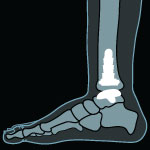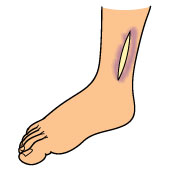 What is a Total Ankle Replacement?
What is a Total Ankle Replacement?
Also known as a Total Ankle Arthroplasty (TAA), a Total Ankle Replacement is usually performed in cases of ankle arthritis where there has been significant damage to the ankle bone and cartilage. During the procedure, the damaged ankle bone and cartilage are removed and replaced with artificial components. The purpose of Total Ankle Replacement is to restore movement to the ankle and relieve chronic ankle pain.
The Procedure
 You will be put under either general anesthesia (where you will be asleep and pain-free) or spinal anesthesia (you will be awake but won’t be able to feel anything from the waist down). The surgeon will cut into the skin over your ankle to expose the bone, then remove the damaged portions of bone and cartilage. Next, the artificial joint (usually made up of metal and plastic components) will be placed inside your ankle and secured with bone cement. Screws may also be used for added stability. Once the artificial components are in place, the wound is stitched up.
You will be put under either general anesthesia (where you will be asleep and pain-free) or spinal anesthesia (you will be awake but won’t be able to feel anything from the waist down). The surgeon will cut into the skin over your ankle to expose the bone, then remove the damaged portions of bone and cartilage. Next, the artificial joint (usually made up of metal and plastic components) will be placed inside your ankle and secured with bone cement. Screws may also be used for added stability. Once the artificial components are in place, the wound is stitched up.
You will probably be required to wear a cast or boot for about 4-6 weeks following the procedure to limit movement of the ankle joint. In order to ensure that everything stays in place, you won’t be able to bear any weight on your ankle for several weeks after the procedure. You may need to use crutches to get around.
What are the Risks?
The risks involved with most surgical procedures also apply to Total Ankle Replacement. These include:
- Infection
- Allergic reaction to anesthesia
- Injury to blood vessels or nerves
- Bleeding
- Blood clot
Complications that are specific to Total Ankle Arthroplasty include bone fractures and inability of the ankle bone to heal, which can both by too much weight-bearing on the ankle too soon after surgery. This is why it is recommended to stay off the ankle and elevate it as much as possible in the weeks following surgery.
Are There Any Restrictions?
Total Ankle Arthroplasty is not for everyone. It may not be advised if you have any of the following:
- Ankle deformity
- Osteonecrosis (bone death) of the ankle
- Ankle infection
- Neuropathy
- Limited blood flow
Alternatives to TAA
Total Ankle Arthroplasty should only be considered if all other treatment options have been exhausted. Before resorting to TAA, you may want to try:
- NSAIDs (painkillers)
- Physical Therapy
- RICE (Rest, Ice, Compression, Elevation)
- Bracing
- Blood flow stimulation